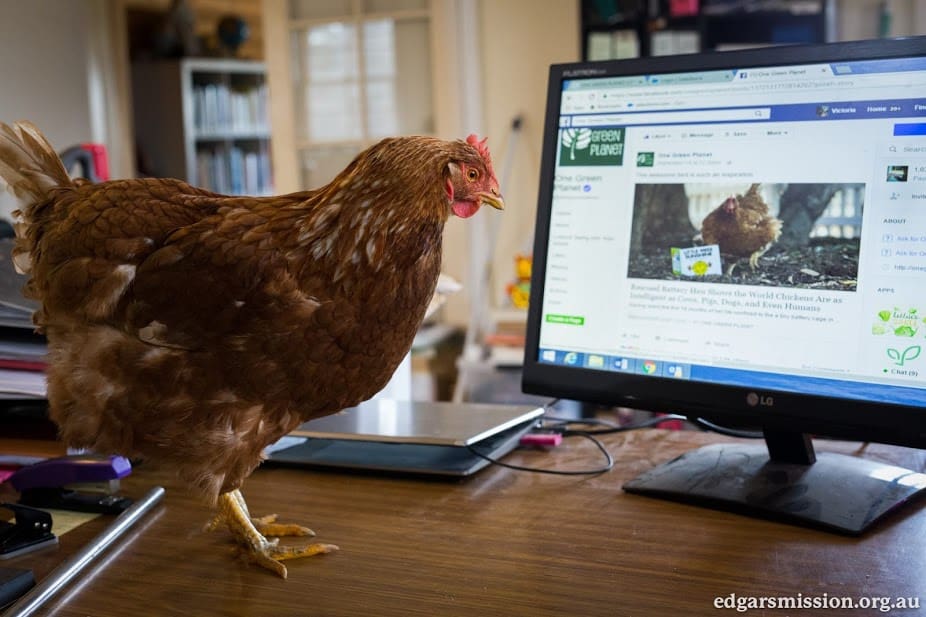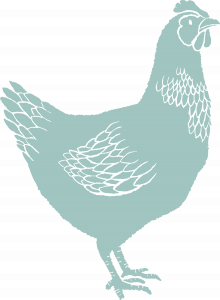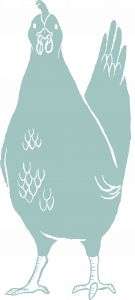
This resource was fully updated on July 18, 2023. It was originally published on November 12, 2020.
Our Basic Chicken Care courses provide detailed information about the fundamentals of chicken care, but there’s always more to know about chicken care and providing sanctuary! In addition to our courses, we offer an extensive, freely accessible digital library covering a wide array of sanctuary-related topics, but we understand it can be difficult to know how to navigate all of the resources we provide, especially for folks who are new to the topic of chicken care! This outline is intended to help course participants make their way through our resources by suggesting specific resources in conjunction with our courses. However, keep in mind that we’re constantly creating new resources, so be sure to follow us on social media or subscribe to our newsletter for regular updates!
Introductory Resources
Regardless of the basic chicken care track you choose (large breedDomesticated animal breeds that have been selectively bred by humans to grow as large as possible, as quickly as possible, to the detriment of their health., non-large breedA domesticated animal breed that has not been specifically engineered to grow as quickly as possible for the purpose of human consumption. In resources at The Open Sanctuary Project, "Heritage" breeds of turkeys, for instance, are "non-large breed", even if they are physically quite big., or both), it can be helpful to learn a bit more about how to start a sanctuary (and what it even means to be a sanctuary), and it can also be helpful to learn a bit more about where the domesticatedAdapted over time (as by selective breeding) from a wild or natural state to life in close association with and to the benefit of humans chicken we know today came from. If you’re not familiar with these topics, the resources listed below may be useful to read before, after, or even while you complete our courses. Additionally, anyone who is or is planning to care for chickens should take time to learn more about highly pathogenic avian influenza (HPAI).
General Animal Sanctuary Resources
If you’re looking for more information about starting a sanctuary or just want to know more about what providing sanctuary to animal residents entails, we recommend beginning with the following resources:
- So, You Want To Start An Animal Sanctuary
- What Defines An Animal Sanctuary
- What Does It Mean For Each Animal Sanctuary Resident To Be An Individual
- Why Residents Shouldn’t Breed At A Farmed Animal SanctuaryAn animal sanctuary that primarily cares for rescued animals that were farmed by humans.
- Choosing The Right Site For Your Animal Sanctuary
- Understanding Your Sanctuary’s Zoning Rights And Restrictions
- Determining Your Sanctuary’s Capacity For Responsible Care
- Starting A Non-Profit Organization For Animal Sanctuaries In the United States
- Weighing The Costs And Benefits Of Non-Profit Status
- Understanding MissionThe stated goals and activities of an organization. An animal sanctuary’s mission is commonly focused on objectives such as animal rescue and public advocacy. And Vision For Your Animal Organization

Looking For More Information?
For more information about starting and operating a sanctuary, head over to our Governance and Organization landing page!
Brief History Of The Domesticated Chicken
Understanding where domesticated chickens came from can help you better understand their needs. For a brief history of the domesticated chicken, check out:
Resources About Avian Influenza
In order to responsibly protect avian residents, one must understand what avian influenza is and the risks associated with highly pathogenic avian influenza, both in terms of the disease itself and legal control efforts. We currently offer the following resources:
- Advanced Topics In Resident Health: Avian Influenza
- Avian Influenza FAQ
- HPAI BiosecurityMerck Veterinary Manual defines biosecurity as ”the implementation of measures that reduce the risk of the introduction and spread of disease agents [pathogens].” Plan And Checklist
- Highly Pathogenic Avian Influenza: Your Sanctuary And The Law
- Highly Pathogenic Avian Influenza And The Law: FAQ For Animal Sanctuaries And Rescues
Basic Chicken Care/Basic Large Breed Chicken Care Part 1 Supplemental Reading
Part 1 of our chicken care courses covers housing, feeding, social considerations, and enrichment. The following subjects are not fully covered in our courses and offer additional information that you may find useful:
- Breaking The Mold: How Animal-Centered Design Can Transform Sanctuaries
- Chicken Living SpaceThe indoor or outdoor area where an animal resident lives, eats, and rests. Maintenance And Cleaning
- Composting 101: The Scoop On Poop
- Sharing Your Home With Chickens
- How An Animal Sanctuary Can Respond To “Backyard Egg” Questions
- What Should A Sanctuary Do With Residents’ Eggs
- Resident Drinking Water Considerations At Your Animal Sanctuary
- Preventing Foreign Body Ingestion At Your Animal Sanctuary
- Fire Safety At Your Sanctuary
- Things That Are Toxic To Chickens
- Compassionate Wildlife Practices At Your Animal Sanctuary
- The Pecking Order: How Does It Affect Flocks?
- The Care Of Chicken Residents In Extreme Cold
Looking For More On Enrichment?
We’ve got a ton of enrichment resources! In addition to species-specific resources, we also have resources that can be applied to all species. Check out our current offerings here!

Basic Chicken Care/Basic Large Breed Chicken Care Part 2 Supplemental Reading
Part 2 covers the following healthcare-focused topics: Establishing A Baseline, Signs Of Concern, Safe Restraint, Health Examinations, Veterinary Care, Preventative Care, New Arrivals, Introductions, and Record Keeping. The following resources are not fully covered in our courses and offer additional information that you may find useful:
- Observation: An Important CaregiverSomeone who provides daily care, specifically for animal residents at an animal sanctuary, shelter, or rescue. Tool
- The Caregiver’s Guide To Developing Your Observation Skills
- Backyard ChickenThe raising of chickens primarily for the consumption of their eggs and/or flesh, typically in a non-agricultural environment. Recommendations In Sanctuary: A Word Of Caution
- Potential Chicken Health Challenges (not necessarily meant to be read straight-through, but gives an overview of other health challenges you may encounter that are not discussed in the course)
- Suprelorin Implants
- Building And Maintaining A Good Relationship Between Your Animal Sanctuary And Veterinarians
- Understanding Veterinary Diagnostics: Fecal Testing
- Understanding Veterinary Diagnostics: Blood Work
- Understanding Veterinary Diagnostics: Culture And Sensitivity
- Establishing Safe And Effective QuarantineThe policy or space in which an individual is separately housed away from others as a preventative measure to protect other residents from potentially contagious health conditions, such as in the case of new residents or residents who may have been exposed to certain diseases. And IsolationIn medical and health-related circumstances, isolation represents the act or policy of separating an individual with a contagious health condition from other residents in order to prevent the spread of disease. In non-medical circumstances, isolation represents the act of preventing an individual from being near their companions due to forced separation. Forcibly isolating an individual to live alone and apart from their companions can result in boredom, loneliness, anxiety, and distress. Protocols For Your Animal Sanctuary
- How To Create An Effective Rescue Policy For Your Animal Sanctuary
- Establishing A SurrenderThe act of transferring guardianship of an animal to a person or organization, especially via legal contract. Policy For Your Animal Sanctuary
- 25 Questions To Help Guide Responsible Intake Decisions At Your Animal Sanctuary
- Introduction To Rooster Behavior Part 1: Dismantling Rooster Stigma
Further Reading
The resources listed above are just the beginning! We have hundreds of available resources on a wide range of topics. We encourage you to spend some time browsing our extensive library of resources or, if there is something specific you are looking for, using the search tool to see if it’s something we cover. (If you can’t find something you’re looking for, feel free to contact us!) Below is just a sampling of some of the topics we cover!
Chicken/Bird-Specific Resources
- Care Recommendations For Chicks (Baby Chickens)
- Additional Care Recommendations For Older Chickens
- Large Breed Chicken Care Considerations (for those who did not take the large breed courses)
- Introduction To Supportive Care For Chickens With Disabilities: Non-Ambulatory Chickens (three-part series)
- A Guide To Safely Catching Stray Birds For Your Animal Sanctuary Or Rescue (four-part series)
- Fun Facts About Chickens
Other Sanctuary Resources
- Avoiding HarmThe infliction of mental, emotional, and/or physical pain, suffering, or loss. Harm can occur intentionally or unintentionally and directly or indirectly. Someone can intentionally cause direct harm (e.g., punitively cutting a sheep's skin while shearing them) or unintentionally cause direct harm (e.g., your hand slips while shearing a sheep, causing an accidental wound on their skin). Likewise, someone can intentionally cause indirect harm (e.g., selling socks made from a sanctuary resident's wool and encouraging folks who purchase them to buy more products made from the wool of farmed sheep) or unintentionally cause indirect harm (e.g., selling socks made from a sanctuary resident's wool, which inadvertently perpetuates the idea that it is ok to commodify sheep for their wool). to Animals At Your Animal Sanctuary
- The Challenges Of Responsible Animal RescueAn organization that helps secure animals from dangerous or unacceptable situations. As organizations, rescues may or may not have dedicated permanent infrastructure for housing animals.
- Managing Cruelty, Seizure, And Escapee Cases At Your Sanctuary Or Rescue
- A Guide To Evaluating Farmed AnimalA species or specific breed of animal that is raised by humans for the use of their bodies or what comes from their bodies. Care Sources, Recommendations And Information For Your Sanctuary
- Biosecurity (two-part series)
- Resident Behavior 101 For Animal Sanctuaries
- Building Your Resident Emergency Healthcare & First Aid Kit
- Keeping Track Of Sanctuary Tasks (two-part series)
- The Fundamentals Of An Effective Tour Policy
- An Introduction To Educational Programs And OutreachAn activity or campaign to share information with the public or a specific group. Typically used in reference to an organization’s efforts to share their mission. Well-Suited For MicrosanctuariesMicrosanctuaries are small scale communities of human and nonhuman (generally “unconventional or farmed”) animal companions, who live together in a chosen shared lifestyle and in commitment to ending the oppression of all beings. Microsanctuaries adhere to the notion that no nonhuman member of the community should “serve a purpose.” Microsanctuaries can exist in any context: rural, suburban, or urban. A microsanctuary can consist of as small a community as one animal and one human caregiver. For more information on microsanctuary please refer to the Microsanctuary Resource Center.






